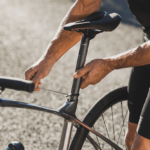Bicycle handlebars come in an array of shapes and configurations these days. While the diversity looks cool, not all handlebar types are ideal from a speed and performance perspective. Certain styles cause slower steering response and less powerful pedaling positions. Let’s explore why some handlebars impede speed, and key factors in choosing faster, more efficient ones for your ride.
Why Some Bicycle Handlebars Slow You Down
You grip it every time you ride, so the design of your bike’s handlebars significantly impacts speed and handling. Some stylistic variants look aesthetically pleasing but counteract fast steering and pedaling:
1. Alt/Riser Bars: The backswept, elevated shape of these handlebars may seem ergonomic. But the weight distribution and altered wrist angles make them slower for racing and aggressive riding.
2. Wide/Beach Cruiser Bars: While ultra-wide handlebars provide enhanced control for casual cruising, their wind-catching span slows acceleration and maneuverability for faster cycling styles.
3. Odd Shaped Drop Bars: Eccentric drop bar shapes with multiple curves look stylish but reduce aerodynamics. Stick with traditional bend drop bars for best speed potential.
4. Heavy Materials: Steel and thick aluminum alloys allow durable, eye-catching handlebar shapes. But lugging extra weight dulls acceleration and sustained top speeds.
So style and form have to follow function if racing performance matters. But how do you determine which handlebars offer the best fit and speed potential?
Choosing Faster, More Efficient Handlebars
The optimal handlebar shape for your bike depends on factors like your flexibility, riding goals, and terrain. Use this criteria to select the best performance-enhancing fit:
1. Intended Use: Are you racing or aiming for greater speed? Traditional road and aerodynamic bars facilitate faster steering inputs.
2. Material Lightness: Favor lighter metals like titanium, aluminum, and carbon composites for reduced weight and easier acceleration.
3. Ideal Width: Road bikes need narrower widths for aerodynamics; mountain bikes can use wider spans for control.
4. Preferred Hand Position: Determine ideal grip placement – tops, hoods, or drops – based on wrist flexibility and riding style.
5. Bar Shape/Drop: Moderate drop heights and simple, gently curving shapes promote responsive, fatigue-reducing positioning.
By balancing these key factors against aesthetic appeal and your cycling goals, zeroing in on a faster handlebar for tackling roads or trails becomes much easier.
FAQs About Bicycle Handlebars for Speed
Here are answers to some common handlebar questions from performance-minded cyclists:
1. Do straight handlebars slow you down?
In general, yes. The flat shape catches more wind than curved drop bars or aerobars. But new comfort designs aim to improve on older straight bar limitations.
2. What are the fastest road bike handlebars?
Traditional round drop-bar shapes with shorter reach and drop dimensions, allowing changes hand positions. Aero bars also continue gaining support.
3. Are mountain bike handlebars slower?
The wider, flatter design and more upright stance of most mountain bike handlebars facilitates technical riding but impedes matching road bike top speeds.
4. Should I cut down my handlebars for speed?
Some cyclists do trim handlebar width for an aerodynamic boost and quicker handling. But be careful not to compromise stability, comfort or control in the process.
5. Do wider riser bars slow you down?
Yes, the broad wingspan created by really wide riser bars invariably catches more wind resistance, slowing acceleration and top speeds.
Conclusion
Don’t settle for bicycle handlebars based purely on distinctive looks or what came stock. Choosing the best handlebar design for faster riding depends on carefully weighing factors like materials, width, positioning, aerodynamics and – most importantly – matching your intended cycling discipline and goals. While no universal “perfect” shape exists, prioritizing function over form will serve your need for speed far better





